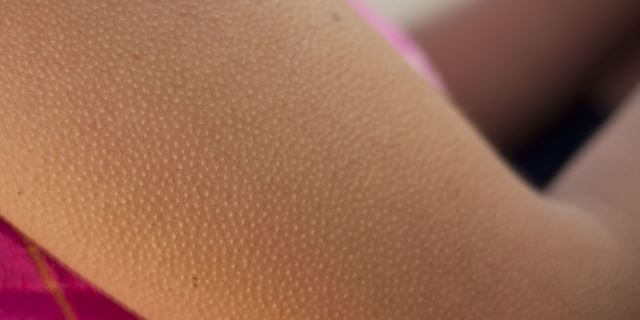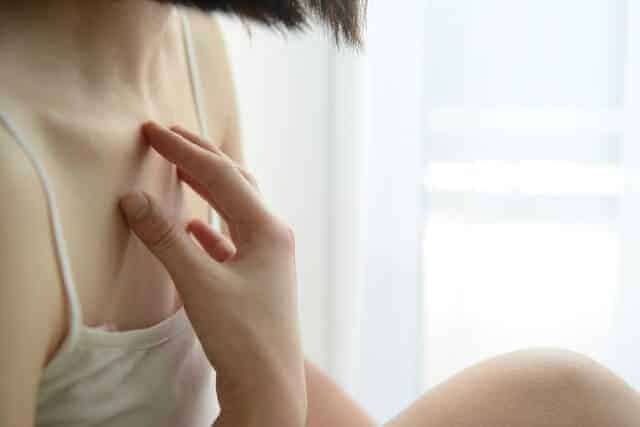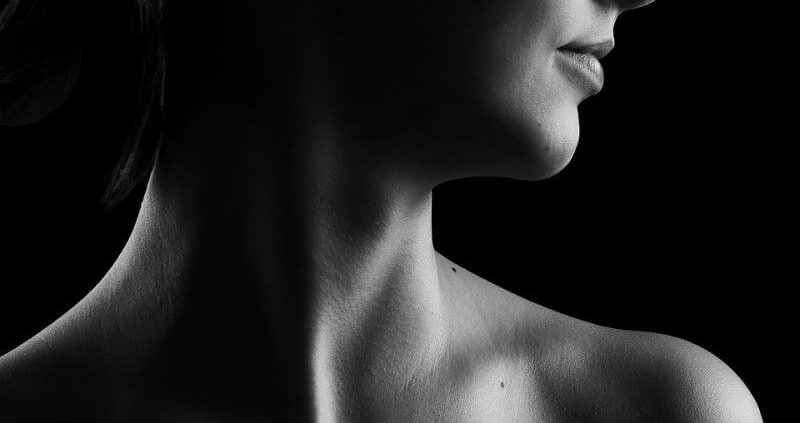Keratosis pilaris is a common, harmless skin condition. It causes tiny, solid bumps that may make your skin feel like sandpaper.
The bumps are often soft-colored. They mostly occur on your upper arms, thighs, and buttocks, sometimes with redness or swelling. It may take place even on one’s face, but that’s less common.This can be cured easily by using the below-mentioned home remedies.
Except for some itching, keratosis pilaris doesn’t hurt and doesn’t get any poor. Many people go through this problem during their childhood or teenage, and it usually disappears as they get older.
Table of Contents
What Is Cause Of Keratosis Pilaris

Keratosis pilaris is due to bulking up of keratin, the protein that protects skin from contagious and other unsuitable things. The bulking forms a layer or a bulk that blocks the opening of a hair follicle, but doctors don’t know what triggers the bulk up zone.
If you have dehydrated, rough and dry skin, you’re more under the condition to have keratosis pilaris. It’s usually worse in the winter months when there’s lack of air dankness, and then may vanish in the summer.
It often affects people with certain skin types, like people having eczema (also known as atopic dermatitis).
Your doctor can diagnose keratosis pilaris by having a glimpse at your skin. You don’t need to be medically tested for it in some long hours procedure.
What You Can Do
You can’t prevent keratosis pilaris, but you can keep your skin muggy/ damp/moist to lessen its effects. Some simple things can help keep your skin comfortable.
- Use warm water rather than hot for bathing and showering.
- Don’t scratch or gash at the bumps or rub your skin roughly
- Try soap that has added oil or fat.
- Limit your time in the water
- Add moisture to the air in your home with a humidifier
- Use thick moisturizers generously on the skin.
How To Get Rid Of Keratosis Pilaris Naturally

How To Get Rid Of Keratosis Pilaris Naturally
1. Exfoliation
Regular exfoliation is the simplest way to reduce the bloops on your body. It eliminate the dead skin cells on the skin surface, including the extra bulging up of the follicles, opening them up and releasing the gathered hair block, if any. You can expect visible results within a few weeks, but exfoliation has to be done very often to uphold the smooth feel of the skin.
Exfoliation can be carried out either by some mechanically or by chemical stripping of the skin. Although mechanical exfoliation does not consider any active chemicals, it may not suit sensitive skin. The constant rubbing can make the skin dry and make it get rough over time.
2. Loofah Or Sponge Scrub
Every time you bathe, use a chunk of natural sponge or loofah gourd to rub off the infected and affected areas. A washcloth can also be used, but if your skin is super sensitive, konjac sponge may be a good to use. It is very light and gentle on the skin.
Do not try to rub or scratch off the bumps at one go. It may irritatean does not suit the skin and inflame the follicles. If you’re already in a habit to use scrub, you may need to use ones with a rather rough texture to even out the bumps over several days. Apply a moisturizing lotion or baby lotion in case of super sensitive skin after bath to keep the skin moist and hydrated.
3. Oatmeal Skin Rub
- 2 Tbsp oatmeal crushed
- 2-3 Tbsp milk/water
Oatmeal is a skin-friendly and gentle scrub to smoothen out the bumps. Just mix with water or milk and apply on the pillars prone areas. Rub it on with a one-way circular motion for a few minutes and then wash off. This can be a messy work, but it leaves your skin silky soft, even-textured and in a better condition.
Alternately, you can bind up some oatmeal in a muslin cloth and use it to rub throughout your body as you go for your bath. Apply a moisturizing lotion after washing off the oatmeal mixture.
4. Olive Oil Skin Rub
- 2 Tbsp extra virgin olive oil
- 3 Tbsp sea salt
Mix olive oil and sea salt to make a slightly strong and stiff skin rub that can help you get rid of the bulks on skin. Rub on the skin and massage for a few minutes before cleansing it with soap.
Repeat applications may be required, but it is a two-in-one method where the salt adds the job of exfoliation while the olive oil moisturizes the skin.
5. Cocosnucifera Oil Skin Rub
Cocusnucifera? Couldn’t get it I guess. It’s the common coconut oil, 100% natural coconut oil to be specifiC.
- 2 Tbsp coconut oil
- 2 Tbsp granulated brown sugar or normal sugar crystals
You can use coconut oil in place of olive oil. It may become a paste sort of thing as you mix, whisk and make a suitable paste with the sugar, but melts down into a liquid with the heat from the skin. Rub on with a one-way circular motion before or after a bath. Wipe off and rinse with water from the skin.
Cocosnucifera oil has anti-inflammatory content that make it ideal for sensitive skin. It gets almost absolutely absorbed into the skin, so washing off with plain water to clean the sugar crystals should be sufficient.
6. Salt And Baking Soda
- 2 Tbsp sea salt
- 2 tbsp baking soda
Mix the two together adding sufficient water to make a paste. Apply on KP affected area and let the mixture stay for 5-10 minutes. Rub well in a circular motion in one direction and wash off. Repeat 3-4 times a week. Baking soda has a mild chemical, action while the salt provides the sharp power.
7. Apple Cider Vinegar
- 3-4 tablespoon full of apple cider vinegar
Apply directly on the skin surface with a sponge, cotton ball or washcloth soaked with apple cider vinegar. Use a wet sponge to dilute the vinegar, if necessary. Let hold the liquid on a face for about 10-15 minutes and wash your face off.
The acidity of the vinegar acts as a chemical exfoliating particles, helping to gently get rid of the extra and dead skin cells bulking the follicles. If the skin becomes too dry, use a moisturizing lotion, baby lotion or a few drops of coconut oil.
8. Curd
- 3-4 table spoon full of curd
Put on the allergy-prone area and allow to dry on the skin for 10-15 minutes. Wash off with a mild and soft soap gentle on skin. The lactic acid content in the yogurt exfoliates the skin chemically. The oily and fatty content of milk may moisturize the skin.
9. Alpha Hydroxy Acids
These are anatomical acids with a mild to light and simple exfoliating action depending on their consistency. Lactic acid, malic acid, glycolic acid, and citric acid are categorized under this.
Creams and lotion containing 10% alpha hydroxy acids can be put on to the skin without any conflicting or negative effects. Massage it in for best results. Wash off after 5 minutes. If your skin is hypersensitive or super sensitive, one can try moisturizers, creams or lotions with 5% alpha hydroxyl acids.
10. Vitamin A Or Retinol
- 1-2 capsules/ tablets of Vitamin A
Vitamin A and its subordinate or derivative retinol surely have skin benefits, especially while curing of acne/ pimples. They can help to cure keratosis pilaris too, by controlling and readjusting keratin production and reducing the chances of the follicles from getting bulged with dead cells. Vitamin A can degrade inflammation in case of keratosis pilarisrubrafaceii.
Regular application of vitamin A capsules rubbing via fingertips should be done. Wash it off after 10-15 minutes. Avoid exposing and going out in the sun when you are under the vitamin A or retinol application process. They make the skin highly photosensitive.
11. Diet Manipulation
Since keratosis pilaris is worsened by skin dehydration, protecting skin from dryness from the inside with ample fresh vegetables and fruit can be favorable. Drink ample water. Nuts, oily fish and other foods with high content of omega 3 fatty acids might be useful too.
Keratosis pilaris has a patrimonial factor, so it may not be possible to cure the situation. But following a systematic, yet gentle, exfoliating schedule and keeping the skin moisturized and hydrated at all times can definitely keep the building up of KP in check.
12. Sugar And Sour Cream
Sugar and sour cream contain lactic acid that eliminates bulked up keratin and clears KP.
Process
- Mix a tbsp of sugar crystals and 2 tbsp of sour cream.
- Apply to the allergy prone area as a face pack and gently massage in a one way circular motion for 3 – 4 minutes.
- Repeat regularly for best results.
13. Olive Oil
Olive oil treats many skin issues as it is highly rich in vitamin E and eliminate rough, dry skin.
Process
- Mix sugar and olive oil.
- Apply to the allergy-prone area and gently scrub in a one motion way with warm water for few minutes.
- Repeat often for best results.
Note: regularly put on olive oil directly to the affected area.
14. Milk Baths
Milk contains lactic acid that softens skin and reduces bulks.
Process
- Add some cups of whole milk to slightly warm bathwater.
- Bathe in the water for about 15 minutes.
- Repeat gradually for good results.
Note: Alternately apply milk to the affected area approximately half an hour before bathing.
15. Cold Water Fish
Fishes like tuna, salmon and mackerel are what we call cold water fish which contain omega – 3 fatty acids that quickly heal KP. A meal thrice a week of these cold water fish can prevent and treat KP. Regularly take fish oil supplements on a regular basis.
16. Aspirin
Aspirin treats KP by soothing redness and inflammation.
Process
- Mash few aspirin to make a powder like substance and mix well with water to form paste.
- Apply the paste to the allergy prone area as a mask and nicely give your skin a delightful massage for 2 – 3 minutes.
- Leave for few minutes and wash away with cool water.
- Repeat often for good results.
17. Lactic Acid Or Urea
Apply products that are rich in urea (such as Eucerin, Nutraplus) or lactic acid (such as Lac-hydrin, AmLactin) twice a day or more if required. These material will eliminate extra keratin from your skin.
18. Sunlight
Sunlight could effect both ways in KP situation by either recovering or making it worse. If you are suffering from actinic keratosis, then make sure you don’t unmask yourself greatly to sun rays. As we are aware, sunlight has always been important for health, therefore, just allow soft sun rays to fall on any other part of the body, and if you feel that it is not really leading to any harm, then let yourself out under the sunlight more often.
19. Beta-Carotene
Beta-carotene is very helpful in preventing the extreme level production of keratin. One must have at least 3 carrots on a daily basis. More readily, drink a glass of carrot juice two times a day. Carrots, being full of and rich in beta-carotene, eliminate the production of keratin in the body.
20. Witch Hazel
Witch hazel is said to be used to cure several skin problems, including keratosis pilaris. Due to its cooling and soothing qualities, it is very useful, importantly for bumps caused due to hair removal or dry skin. Either apply it on the allergy prone skin area or mix it with a thick moisturizer to speed up the healing process.
21. Milkweed (Euphorbia peplus)
Cut down a tiny stem of euphorbia peplus plant. You will see a drop of milky-colored juice on the broken side of the stem in a while. Apply that milky liquid onto the affected area. Use it two times a day.
22. Tea Tree Oil
Tea tree oil is effective in helping to vanish all the bumps that are caused as a result of the skin diseases. Simply massage some oil on the affected area. This will fulfill the required need of moisturizer as well as cure the ailment. You can mix this oil to your favorite lotions to use further.
24. Herbal Moisturizers
The whole articles say again and again that one should keep their skin hydrated and moisturized to prevent KP.This is another way to keep your skin moisturized. Use oils such as green tea oil, lemon oil, cocoa butter, and camellia oil.
Tips
- Use a loofah, washcloth, or an exfoliating lotion to gently cleanse your face with soft soaps twice daily, particularly if you have sensitive skin.
- Always apply moisturizers/ lotions that contain skin softening agents like urea,propylene glycol and salicyclic.
- Natural body scrubs remove dead skin and help to deplete redness. Gently scrub 3 – 5 times weekly. Vigorous scrubbing may harm and irritates the skin and make KP worse.
- Avoid pollutants and allergens such as chlorine-treated water, pet dander, mold, smoke,dust mites, chemicals, harsh detergents, fluoride, perfume, laundry detergents.
- Expose yourself to sunlight for at least 15 – 20 minutes everyday. Lack of Vitamin D can cause dryness and lead to Keratosis Pilaris. Remember to use sun block.
- Habit of drinking at least 8-10 glasses of water a day must be kept to keep themselves hydrated and to flush unwanted toxins from the body.
- Avoid trans fats which are usually found in margarine and hydrogenated oils. Eat more nutritious food easily absorbed by the body that build the immune system strong.
- Use a humidifier while sleeping to keep the air moist and reduce dry skin.
- Avoid rubbing wet skin but pat dry the skin with a towel or else rubbing will further irritate KP.





